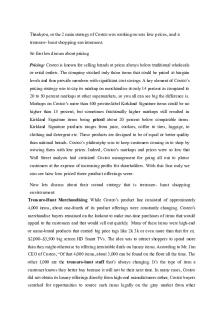Costco Case study 2019 PDF

| Title | Costco Case study 2019 |
|---|---|
| Course | Strategic Management for Management and Organizational Studies |
| Institution | The University of Western Ontario |
| Pages | 3 |
| File Size | 73.3 KB |
| File Type | |
| Total Downloads | 47 |
| Total Views | 168 |
Summary
CASE ANALYSIS 2019 for CLASS PARTICIPATION...
Description
Costco Identify vision and mission would be about 5-10 marks. Mission: warehouse discount, volume based retail merchandising. To continually provide our customers with quality gods at the lowest possible price. No vision- could be a recommendation. Objectives: - Increases same store sales by 5% - Carbon footprint grows slower than company growth - Build Kirkland to 30% of sales. - Decrease waste: don’t use grocery bags to put products in - Increase customer retention for memberships - Low employee turnover SMART: when do you want to grow? Many goals are short term focused: no real time constraint, they want to grow more stores, but what is the time frame? No long term goal. Maybe need to add some time frame. Low employee turnover can be measured. Percentage of turnover rate… was there a percentage number? Maybe include a recommendation of numbers. Industry Analysis: Porters: Rivalry is high: low cost business more than high cost. Entry to competitors: Sam’s club is a direct competitor… target can start into a membership retailor. Bargaining power of suppliers: it can be lower due to 80% of stuff is from one supplier than other various suppliers. Forward integrated more than horizontally. Mostly merchandise highly skilled labour that may be unionized? Entry of new competition: Sam’s club not too high. Potential substitutes: going to any retailor, gas stations, pharmacies, online retailor shopping, Walmart, grocery stores. Moderate to high switching costs. PEST analysis: Demographic: upper to mid class- consumers (positive) Socio cultural: culture of shopping (negative), enviornmental Technological: website sales, effeciency Political: minimum wage (negative) Implications :min wage can be good long term cause wage is going up , managers can earn up to 60-70 k a year and can maintain a good lifestyle in the long term future. Management ability to move things around for the economy. Trends to the growth of the industry. Global : expansion opportunities for costco stores. Evaluate each country cause maybe it won’t out for certain markets. Susceptible to economic swings: what is the nature of the way the business is going? Key success factors from competition Costco:
Product offerings (high quality): 3700 Inventory turnover: 31.2 days Efficiency/ low cost: 3.1%-- 3624/116199 (operating income) Convenience locations: 698 Membership volume: 81, 300,000 Volume sales: 116, 199, 000 Location: Supplier relationships/ brands: metric rankings for each one Sam’s: Product offerings (high quality): 4000 Inventory turnover:0 Efficiency/ low cost: 3.4% Convenience factors: 802 Membership volume: Volume sales: 58,000,000 Location: Supplier relationships/ brands:
BJ’s wholesale: Product offerings (high quality):7000 Inventory turnover: 36.9 days Efficiency/ low cost: 1.9% Convenience factors: 210 Membership volume: Volume sales: 10,800,000 Location: Supplier relationships/ brands: Implications: Costco is doing way better than the rest. Membership fees, people love Costco due to free samples and quality bulk grouped products.]
Current Strategy: Low cost- broadly focussed. Costco sale:8.9%... 6.9% sales for 2011 Membership fees: 8.94%...6.62% Operating income: 8.7%.....10.41% Net income: 9.24%--> costs are growing slower than sales which is good. For 2011 it is 12.92% Sam’s club: Sales: 4.07% Fees: 2.49% OI: 3.91% NI: 0
Costco International and Costco U.S/ Canada:
International: 16.48% 19.889% Implications: U.S and Canada is doing okay and international is growing, we must see how they are doing. 12.48% of the total is coming from sales in international. Canada was about 15%. Growth is good. SWOT: S: efficient, $/sq. foot, merchandise, and membership fees, brand, marketing tactics. W: only sell in bulk, only members can access store, commitment to go, needa car O: more stores, expand to online retail, incentives to buy more stuff, T: Value chain: Supplies distribution center Costco retail customer Goes from distribution to customer through via online website Comp advantage: matters to customers, durable, low cost high quality products. Recommendations:...
Similar Free PDFs

Costco Case study 2019
- 3 Pages

Costco Case Study
- 8 Pages

Costco - case study
- 2 Pages

Costco - case
- 1 Pages

Costco (14) - case
- 1 Pages

Case study : Amazon.com, 2019
- 4 Pages

Costco Case Questions
- 3 Pages

Costco (12) - case
- 1 Pages

Costco (19) - case
- 1 Pages

Costco Case - NOTES
- 2 Pages

Amazon-go-2019 case study
- 11 Pages

Starbucks Case Study 2019/2020
- 9 Pages
Popular Institutions
- Tinajero National High School - Annex
- Politeknik Caltex Riau
- Yokohama City University
- SGT University
- University of Al-Qadisiyah
- Divine Word College of Vigan
- Techniek College Rotterdam
- Universidade de Santiago
- Universiti Teknologi MARA Cawangan Johor Kampus Pasir Gudang
- Poltekkes Kemenkes Yogyakarta
- Baguio City National High School
- Colegio san marcos
- preparatoria uno
- Centro de Bachillerato Tecnológico Industrial y de Servicios No. 107
- Dalian Maritime University
- Quang Trung Secondary School
- Colegio Tecnológico en Informática
- Corporación Regional de Educación Superior
- Grupo CEDVA
- Dar Al Uloom University
- Centro de Estudios Preuniversitarios de la Universidad Nacional de Ingeniería
- 上智大学
- Aakash International School, Nuna Majara
- San Felipe Neri Catholic School
- Kang Chiao International School - New Taipei City
- Misamis Occidental National High School
- Institución Educativa Escuela Normal Juan Ladrilleros
- Kolehiyo ng Pantukan
- Batanes State College
- Instituto Continental
- Sekolah Menengah Kejuruan Kesehatan Kaltara (Tarakan)
- Colegio de La Inmaculada Concepcion - Cebu



